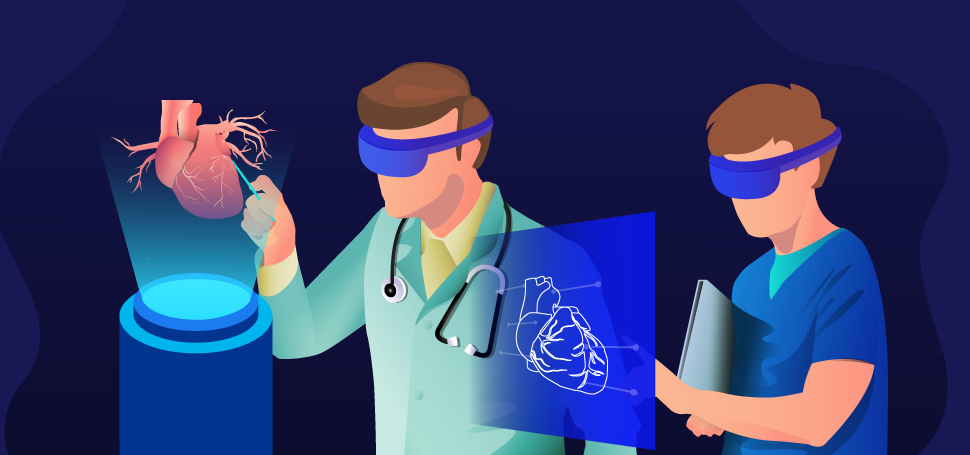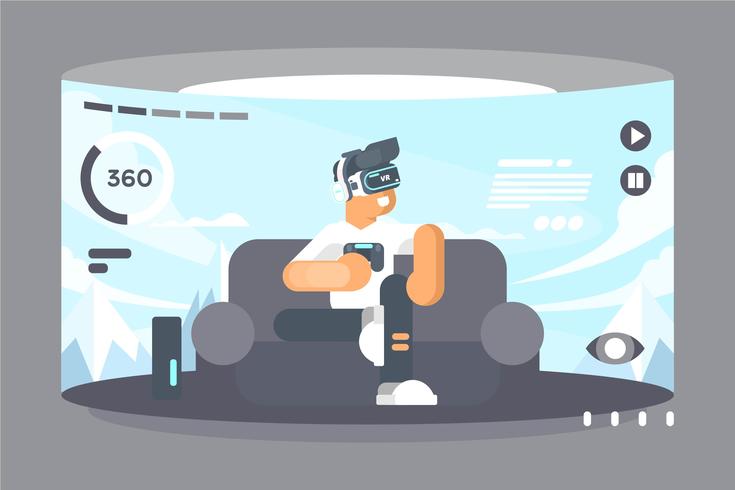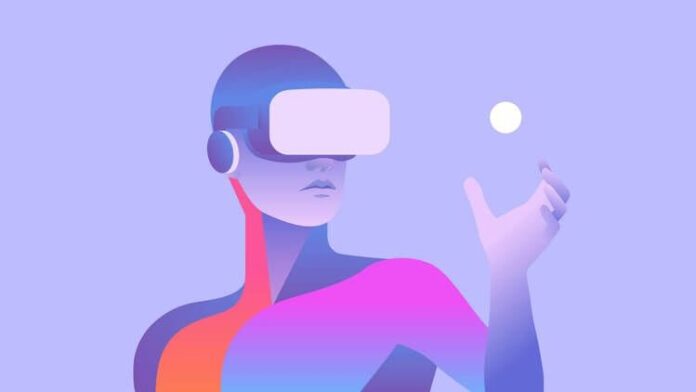Augmented reality (AR) conveys digital information in a 3D environment, presenting the data as an augmented version of the real world. In a similar fashion, virtual reality (VR) projects a simulated 3D setting that is constructed via computer software and relayed through headsets or handheld devices.
There have been increasing advancements in AR and VR technology, with more companies driving the market expansion and investing in cutting-edge equipment to take part in this opportunity. It is estimated that the AR and VR industries combined could reach a value of $78.45 billion by 2025.
1. Advertising
Companies have taken a keen interest in AR and VR technologies to optimize their marketing and get the attention of potential customers. Many brands are already talking about it, curious about how AR/VR works and excited to get the ball rolling. It’s not surprising to find businesses trying to advertise their products and services on inversion hardware from VR headsets to the overpriced oculus rift. Several ambitious brands have successfully implemented AR and VR into a bunch of creative marketing campaigns.
Travelers may look forward to an incredible preview of their next vacation spot. Virgin Holidays is giving their customers an immersive tour of exotic destinations including a realistic exploration of Mexico’s Riviera Maya or a close-up of dolphins swimming in Xel-Ha park. Using VR headsets, they can plan their trip in advance and enjoy a unique experience that would be hard to illustrate on a simple brochure.
Arguably the most impressive promo for a TV show is Netflix’s VR advertisement, featuring an obstacle course that takes viewers inside the Ultimate Beastmaster. Obstacles like the Digestive Tract will have numerous intimidating twists and turns so they get to anticipate what the actual contestants are up against before the first episode is out.
2. Healthcare
The ever-increasing demand for healthcare technology has led to the development of new diagnostic tools and effective medical treatments. This is evident in the application of augmented reality to the 3D imaging of vital organs, displaying high resolution visuals to identify signs of abnormal tissue growth. AR has improved existing technologies as seen in magnetic resonance imaging (MRI) along with X-ray scans that clearly highlight a patient’s skeletal structure, enabling surgeons to perform operations with fewer complications.
The current state of AR and VR in healthcare suggests many factors are responsible for its rising interest among medical practitioners. One of these is the integration of AR and VR in clinical testing, drug therapeutics, complex surgical procedures, diagnostic imaging, and of course, training of hospital staff. AR and VR simulations allow healthcare professionals to use safe and noninvasive diagnostic tools to provide a better patient experience.
Another contributing factor is the release of data collection apps for quickly extracting data from patients profiles. This type of data visualization would reveal insights about the patient’s condition so that an accurate diagnosis is possible and specialists can prescribe the correct treatments. In response, research facilities are focusing their efforts on designing medical instruments with optimal speed and precision in VR and AR areas. Granted, the introduction of depth sensing and body mapping is just the beginning.
3. Education
AR and VR have made a significant impact on educational institutions, by changing the way students are taught in classrooms. In recent years, K-12 has adopted a curriculum of assistive learning to meet the needs of students who are excluded from the traditional, once-size-fits-all model or have struggled with standardized testing. As a result, virtual learning has taken off in public schools with interactive courses on tablets, online learning modules, and augmented, stress-reduced environments to help students foster an appreciation for diverse subjects.

Study experts have discovered that VR simulations are capable of supporting students with disabilities so they acquire the necessary skills to catch up to their peers. VR technology lets students practice their communication skills, overcome social anxiety, and improve their executive functioning through group-oriented instructions. Students who wear headsets were less likely to be distracted by noise and other disruptive activities, being able to focus on their assignments instead.
In addition, AR and VR was praised as a solution for managing ADHD in the classroom. Excessive smartphone use has gradually reduced the attention span of children, which means they are reluctant to sit through long lectures and will miss important points explained by the teacher. Fortunately, VR-based learning actively engages students by adding fun games and intriguing stories to online lessons, even providing an opportunity for children to experience field trips regardless of where they are.
4. Manufacturing
Augmented reality is transforming the manufacturing industry faster than expected. Virtual technology will soon disrupt warehouse, construction, and delivery jobs. Although VR equipment is a safety concern near production lines, AR devices are on the contrary, making this a smoother transition towards lightweight wearables. AR has streamlined manufacturing by guiding workers along the order fulfillment and logistics management process.
AR has made an impact on construction in which workers are able to detect unsafe conditions or visualize the framework of a building in its final stages. In manufacturing, AR wearables supply information related to the task at hand by overlaying descriptions and statistics over visible objects. Trained personnel can use it to measure the temperature of running equipment, evaluate whether a machine is functioning properly, and stay away from restricted areas in the manufacturing plant.
Furthermore, AR can prevent workplace injuries by notifying new employees of the safety guidelines as well as procedures for handling heavier items, while they receive job training. AR is embedded with task guidance, compliance documentation, resource calculating, and parcel scanning features. It also removes the manual aspect of organizing a warehouse: Workers can depend on the system to tell them where products are stored before they scan the barcode and deliver a package onto a loading dock.
Above all, emerging AR technology supports workers with crucial steps such as product design and maintenance in real-time, to help them get things done faster. This in turn, keeps assembly lines moving without consuming too much resources.
5. Online Shopping
To harness the power of AR and VR, eCommerce platforms are exploring “try-on” solutions that are convenient for online shoppers. If customers are too busy to go visit a store, they can just peer into a realistic simulation of the product before they buy. Brands that implement AR are definitely seeing higher conversion rates and fewer demands for refunds.
AR played a significant role in the beauty industry. Brands like Sephora are improving the user experience through AR apps on the smartphone. Since customers are hesitant to choose makeup they haven’t sampled yet, Sephora has released its own Virtual Artist app for them to apply lipstick or blush to a photo of their face instead. It seems face recognition technology is a stellar branding tool.
A fine example of VR in eCommerce is an app launched by eBay called Sight Search VR. The global marketplace eBay had partnered with Myer to develop a virtual store on iOS and Android. Users can simply connect their smartphone to the app itself, then put on a VR headset to discover a huge selection of items they could spin around like a carousel, until they decide to zoom in on one.
Those who express doubts about the viability of AR and VR can look no further than at the widespread integrations in eCommerce, despite the cost of using them in marketing campaigns.
6. Retail Experience
Retail chains have a lot to gain from embracing AR and VR in their brick and mortar stores. It could very well be the next frontier in elevating the shopping experience. AR and VR will offer a variety of benefits: It increases customer engagement, drives more sales with personalized products, minimizes the risk of on-the-job training, props up specific industries, and ensures customer satisfaction as a whole.
Customers can use in-store navigation tools to take a virtual tour down the aisles, making it easier to find what they need, with matching descriptions of products no less. VR headsets are bound to get customers invested in limited-time offers or special discounts. Likewise, retailers can take advantage of VR marketing to present their product listings with captivating 3-D graphics. This would give them a clearer picture of customer preferences and spending behaviors.
AR technology comes equipped with spatial awareness for finding products based on their exact dimensions and physical traits. It displays the color, style, and material of a selected item, saving shoppers time on browsing every available option in the store. Customers now have access to previews of different products without having to try them on directly. As such, assisted-buying has become a mainstay of furniture and beauty retailers.
7. Interior Design
Virtual placement is a creative VR solution for retailers that specialize in home décor. Once again, the decision to purchase is influenced by whether or not customers had a chance to try an item first. To that end, many are requesting the option to arrange furniture in their homes so they can tell if the color and shape of a new appliance is a good fit for their living room.
One recent application involves Houzz, a home remodeling platform for the iOS. This AR app had the ability to rotate and move highlighted furniture inside a room, as long as there was enough floor space. It lets users see how pieces of furniture look if positioned next to each other. In short, it captured a shot of the room based on where the smartphone camera was pointed at.
Another virtual home design app was developed by IKEA for its on-site locations. Here, VR headsets were distributed to store visitors that transports them into a virtual kitchen full of IKEA appliances and furniture. This replica of a kitchen was designed to be both immersive and entertaining as viewers could interact with many items by turning on the lights or taking utensils out of the drawers. The user will get to experience cooking food in a kitchen designed for convenience.
8. Video Games
AR and VR are believed to have emerged from the video game industry. AR software relays information about objects in a user’s field of view in addition to detecting where they are standing at any given moment. VR follows a different concept where a headset blocks out the real world to keep the user occupied with what’s displayed in front of them.

Video games are quickly adapting to the space around them: In the so-called Oculus Rift, users are presented with a 360-degree view of a virtual world, of objectives to complete, characters to interact with, and a story to be invested in. Headsets like Rift can be synced up with controllers that rely on external camera sensors to track the motion of players. A VR hand gear or controller assists players with performing complex tasks in-game.
AR devices enhance a user’s vision with notable transparency. App games like Pokémon Go are implemented with a built-in GPS system, capable of recognizing a user’s surroundings. It utilizes the rear-facing camera to evaluate the depth of people and objects in 3D space. On the contrary, smart glasses including Microsoft HoloLens projects a combination of floating holograms, data overlays, and floating app interfaces for creating intuitive gameplay.
9. Entertainment
Another area that has been taken over by AR and VR is entertainment. Aside from video games, it is also trending in museums, theme parks, and music concerts. AR apps attract more patrons to museums either through virtual tours of new exhibits or audio recordings educating them on the history of various paintings and artifacts. For one, holographic models of animal fossils will make them seem alive to any onlookers.
Virtual art galleries add another layer of creativity to art venues. Visitors can take a digital tour of famous art collections without ever setting foot in an actual museum. Visitors are able to capture a panorama of artworks and upload them onto social media to zoom in on individual parts. Lastly, VR is used to boost musical performances as a lot of fans prefer to watch 360-degree videos of their favorite bands on the headsets they own.
VR is quite a hit at amusement parks. Theme parks have always been the ideal spot for a family-friendly getaway. Action-packed thriller rides and 4-D movies are especially appealing to children, attributing their success to the immersion brought upon by VR technology as well as partnerships with modern films. VR dials up the intensity of rollercoasters with plenty of bright colors and animated characters to get the audience excited about the upcoming twists and turns.
10. Communications
AR and VR are crucial aspects of workplace communication. VR technology enables company teams to prioritize achieving their business goals. By focusing on the relationships between employees, vendors, and clients, companies can benefit from a boost in productivity. After all, communication is key to running a company efficiently.
A fine example of this is Facebook Spaces, a VR app designed for hosting group meetings among coworkers. This app requires a headset such as the Oculus Rift or HTC Vive. It portrays other group members as cartoon avatars so they know who has joined the meeting. With Facebook Spaces, it is easy to work from home as long as employees have a laptop.
Internal communications (IC) experts should work VR into their upcoming campaigns to keep employees informed about business decisions. In one case study, IC specialist Advita Patel, while working at the airport, managed to relocate 11,500 employees into another car park. This was completed in just three months because she proposed VR goggles to stakeholders as a method for predicting the future layout of the airport.
Since virtual reality is meant to engage users on a deeper level, it would be a useful asset in mimicking realistic problem-solving scenarios. To sum it all up, AR and VR are being gradually adopted into a wide range of industries, introducing a 360-degree view to immerse users in a simulated environment. It has the potential to transform entire markets in the near future.
What are your thoughts on virtual reality and the direction it’s heading in? Are you just as excited for simulated technology and its potential to change how people communicate? Let us know in the comments!








